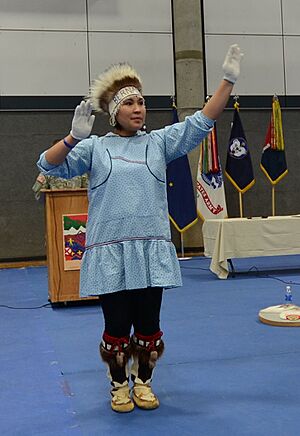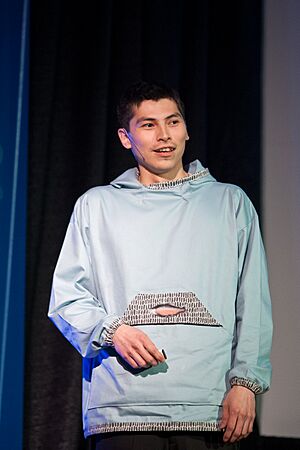Kuspuk facts for kids

A kuspuk (pronounced GUS-puk) is a special hooded shirt. It often has a big pocket on the front. Many Alaska Natives wear kuspuks. These shirts are long, reaching from below your hips to your knees. Some kuspuks for women have a gathered bottom, like a skirt. Most kuspuks are pulled over your head, but some have zippers.
Contents
What is a Kuspuk?
Kuspuks were first worn by the Yup'ik people. Today, both men and women from many Native groups wear them. People who are not Native also wear kuspuks.
Long ago, kuspuks were made from animal skin or gut. People wore them over a fur parka. This helped keep the parka clean. Later, when stores opened in villages, kuspuks were made from fabric like grain sacks.
Modern Kuspuks
Today, kuspuks are usually made from bright cotton fabric. They can also be made from velvet or corduroy. Often, they have decorative trim called rickrack. Many people now wear kuspuks like a regular shirt with pants.
Kuspuks in Alaska's Government
Many lawmakers and their helpers in Alaska wear kuspuks on Fridays. This tradition started around the year 2000. It was begun by Representative Mary Kapsner, who is now Mary Peltola. The rules for dressing in the government say that kuspuks should be worn with dark pants. Because lawmakers like kuspuks, they have become even more popular in Alaska.
Kuspuks and Travel
Sometimes, people wearing kuspuks have had problems at airports. Security screeners from the Transportation Security Administration (TSA) have questioned travelers. This is because kuspuks can be loose and bulky. Screeners have asked passengers to take off their kuspuks.
Senators Lisa Murkowski and Mark Begich have said this is not respectful of culture. They explained that a kuspuk is often worn like a regular shirt. It might not be easy to take off if you are not wearing other shirts underneath.
A Special Gift
In 1981, Pope John Paul II visited Alaska. He was given a kuspuk as a special gift.
Native Names for Kuspuk
The kuspuk has different names in various Native languages.
- In Central Alaskan Yupʼik and Chevak Cup’ik, it is called qaspeq.
- In Nunivak Cup'ig, it is called qasper.
- In Iñupiaq (North Slope and Malimiut), it is called atikłuk.
- In Iñupiaq (King Island), it is called uġiłiqaaq.



